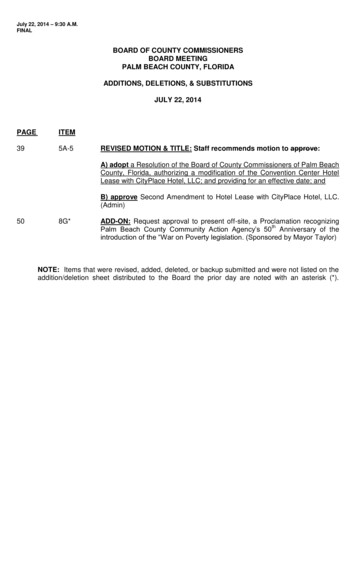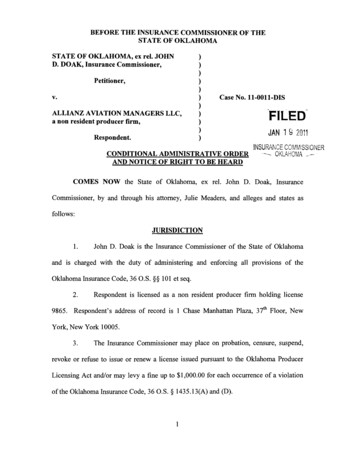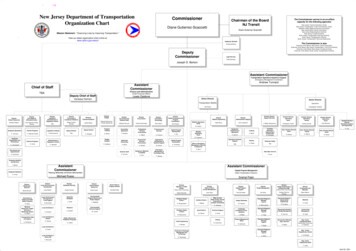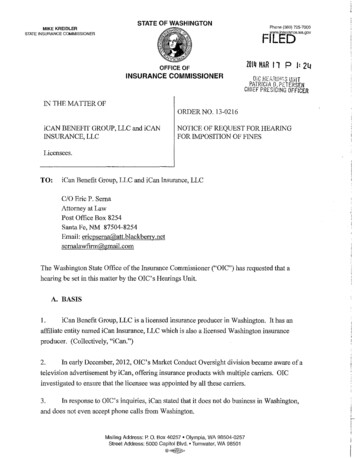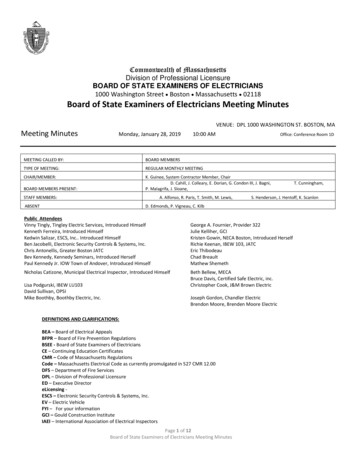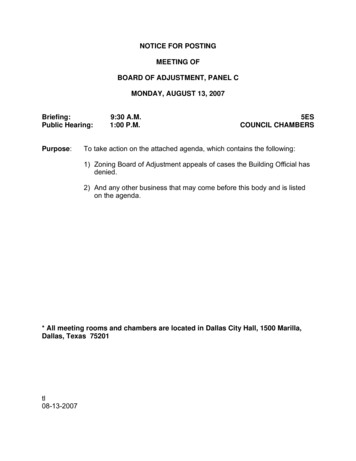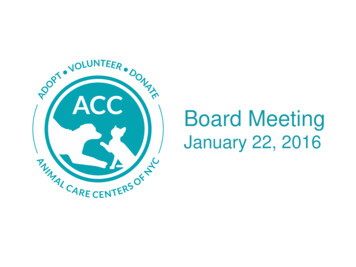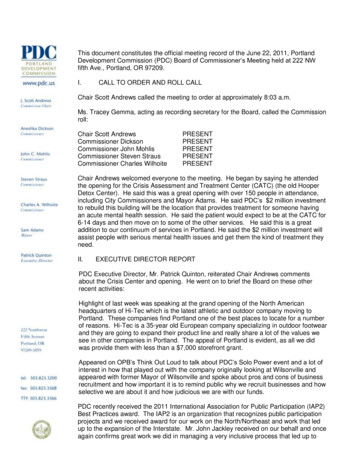
Transcription
This document constitutes the official meeting record of the June 22, 2011, PortlandDevelopment Commission (PDC) Board of Commissioner’s Meeting held at 222 NWfifth Ave., Portland, OR 97209.I.CALL TO ORDER AND ROLL CALLChair Scott Andrews called the meeting to order at approximately 8:03 a.m.Ms. Tracey Gemma, acting as recording secretary for the Board, called the Commissionroll:Chair Scott AndrewsCommissioner DicksonCommissioner John MohlisCommissioner Steven StrausCommissioner Charles WilhoitePRESENTPRESENTPRESENTPRESENTPRESENTChair Andrews welcomed everyone to the meeting. He began by saying he attendedthe opening for the Crisis Assessment and Treatment Center (CATC) (the old HooperDetox Center). He said this was a great opening with over 150 people in attendance,including City Commissioners and Mayor Adams. He said PDC’s 2 million investmentto rebuild this building will be the location that provides treatment for someone havingan acute mental health session. He said the patient would expect to be at the CATC for6-14 days and then move on to some of the other services. He said this is a greataddition to our continuum of services in Portland. He said the 2 million investment willassist people with serious mental health issues and get them the kind of treatment theyneed.II.EXECUTIVE DIRECTOR REPORTPDC Executive Director, Mr. Patrick Quinton, reiterated Chair Andrews commentsabout the Crisis Center and opening. He went on to brief the Board on these otherrecent activities:Highlight of last week was speaking at the grand opening of the North Americanheadquarters of Hi-Tec which is the latest athletic and outdoor company moving toPortland. These companies find Portland one of the best places to locate for a numberof reasons. Hi-Tec is a 35-year old European company specializing in outdoor footwearand they are going to expand their product line and really share a lot of the values wesee in other companies in Portland. The appeal of Portland is evident, as all we didwas provide them with less than a 7,000 storefront grant.Appeared on OPB’s Think Out Loud to talk about PDC’s Solo Power event and a lot ofinterest in how that played out with the company originally looking at Wilsonville andappeared with former Mayor of Wilsonville and spoke about pros and cons of businessrecruitment and how important it is to remind public why we recruit businesses and howselective we are about it and how judicious we are with our funds.PDC recently received the 2011 International Association for Public Participation (IAP2)Best Practices award. The IAP2 is an organization that recognizes public participationprojects and we received award for our work on the North/Northeast and work that ledup to the expansion of the Interstate. Mr. John Jackley received on our behalf and onceagain confirms great work we did in managing a very inclusive process that led up to
PDC Board Meeting Minutes – June 22, 2011Page 2 of 26that expansion and we get a lot of recognition for projects we do but also nice to get recognition forthe public participation work we do.As part of PDC’s ongoing commitment to public involvement approximately 3,000 supernotices forthe expansion of the Interstate Corridor (IC) Urban Renewal Area (URA) were mailed out. Thesenotices give citizens the opportunity to hear about the ICURA expansion and a chance to respond.The expansion is going to the Planning Commission next week and to City Council for vote duringJuly 2011.Groundbreaking event taking place next week for the Oregon College of Oriental Medicine (OCOM).Renovation of the former Glove Hotel in Old Town China Town (OTCT) will be the home for OCOMwhich will relocate its campus in the fall 2012. This new campus will more than double OCOM’scurrent square footage and provide the college with state-of-the art academic, clinical and researchfacility from the ground floor up. The OCOM is one of the oldest Chinese medicine schools in theUnited States. There is an opening for the Zidell Gardens, 11,000 square foot garden developed onthe campus in the South Waterfront. Project sponsored by the Zidell family as tribute to their motherbut to nationally recognize a landscape designer and will be quite an attraction.Attending the Annual Economic Development Summit for the Greenlight Greater Portland which isthe first summit held under the unified regional economic entity and believes an announcement willbe made to share their new name and logo.Portland-Milwaukie Light Rail (PMLR) groundbreaking event taking place next week in SouthWaterfront. This is the next extension of the max and rail line that spans the Willamette Riverbetween South Waterfront and OMSI and will carry light rail, buses, cyclists, pedestrians and, in thefuture, streetcars but no private vehicles. Construction of the bridge is scheduled to begin in Julyand citizens will actually be able to view the construction of this online as they will have a webcamshowing the progress. This will be the first bridge constructed in Portland for over 30 years.Chair Andrews stated the Mayor’s office has asked him to represent the city at the Clinton initiative inChicago next week. The Brookings Institute is presenting the city with an award for our work aroundthe cluster strategy, economic development strategy (specifically around the manufacturing piece).He said he will be participating in panels which directly line up with our economic developmentstrategy.III.CONSENT AGENDAChair Andrews stated as there were no Meeting Minutes to approve and since no citizens signed upfor the public comment period of the agenda, the Board would move to the consent agenda.Chair Andrews said it was a long consent agenda and some changes were made earlier this weekthat will be discussed after all resolutions are called out, first starting with Resolution 6888,“Authorize Short-Term Interfund Operating Loans for Special Revenue Funds,” Resolution 6889,“Approve Amendments to Vanport Housing Easements,” Resolution 6890, “Appoint ExistingMembers for Second Term and Appoint Two New Members for First Term to River District UrbanRenewal Advisory Committee,” Resolution 6891, “Appoint Ms. Sia Sellu and Reappoint Ms. RachelCunningham to the Lents Town Center Urban Renewal Advisory Committee,” Resolution 6892,“Appoint Mr. Irek Wielgosz and Reappoint Mr. Rick Williams and Mr. Owen Ronchelli to the OregonConvention Center Urban Renewal Advisory Committee.”
PDC Board Meeting Minutes – June 22, 2011Page 3 of 26Chair Andrews stated the change made earlier in the week was relative to Resolution 6891 andResolution 6892, as the original resolution had all individuals being appointed to one-year terms andthis was changed so those being added for their first term will actually serve three-year terms. Hesaid this means as new members, Ms. Sia Sellu and Mr. Irek Wielgosz would be appointed to threeyear terms.Chair Andrews made a motion to approve the consent agenda and Commissioner Dickson movedand Commissioner Wilhoite seconded the motion.AYES:NAYS:Andrews, Dickson, Mohlis, Wilhoite, StrausNoneChair called to adjourn the regular meeting for the 8:15 a.m. time certain Tax SupervisingCommission (TSCC) hearing. He said the TSCC will convene a public hearing on thePDC FY 2011-12 Approved Budget.IV.TAX SUPERVISING AND CONSERVATION COMMISSION HEARING ON FY 2011-12APPROVED BUDGETThe TSCC Chair, Mr. Terry McCall, opened the public hearing by stating this is a public hearing ofthe Multnomah County TSCC for the purpose of discussing the 2011-12 Approved Budget for thePortland Development Commission. He said one of TSCC’s responsibilities, as detailed in state law,is to review the budgets of all municipal corporations under the commission’s jurisdiction, sayingTSCC staff have carefully reviewed the budget and worked with PDC staff on technical aspects ofthe budget. He said they have questions concerning the financial policies implicit in the budget,same as a typical citizen might ask, and they would like to have them answered. He said in thissense, the TSCC is here today representing all of the citizens that might not otherwise be able to askquestions of the PDC Board directly. He further stated we encourage citizens to attend these publichearings and learn more about the District’s budget and make any comments that are appropriate.He said Meeting Minutes of this public hearing will be prepared and retained as permanent record ofthe proceedings.Mr. McCall introduced the other four TSCC Commissioners starting with Mr. Javier Fernandez, Ms.Susan Schneider, Mr. Steven Nance, and Dr. Roslyn Elms Sutherland.The questions posed by the TSCC team to PDC’s Board are listed below, along with the PDCBoard’s response:Question 1: Due to the continued recession, real estate market slump and tight credit markets, theprospects for large, privately-funded projects has not improved much since we talked about this lastyear. As a result, the City’s and PDC’s emphasis in this budget has switched to job creation as amain focus. Can you detail some of the specific strategies and programs you are undertaking toaccomplish the City’s goal of creating 10,000 new jobs by the year 2014?Chair Andrews Response: This year’s PDC Budget continues the intentional approach to integratereal estate and job-creation objectives. This approach has nothing to do with a slumping real estatemarket and lack of large privately-funded projects.The City and PDC’s traded-sector economic development work drives job creation by raising thenational and international profile and competitiveness of Portland’s target cluster industries: CleanTech, Advanced Manufacturing, Athletic & Outdoor, Software, and Research & Commercialization.This approach to economic development is highly effective because it helps organize disparateefforts such as business retention and expansion, recruitment, innovation, entrepreneurship, land
PDC Board Meeting Minutes – June 22, 2011Page 4 of 26assembly and workforce development. Working on these issues directly with private industry leadsto greater competitiveness for Portland and ultimately to job growth.We are proactively investing tax increment financing (TIF) in real estate developments in a mannerthat leverages high-growth industries to increase jobs and employment opportunities.Question 2: While it is certainly important to create jobs as a means to spur economic recovery inPortland, how will these strategies and programs lead to increased assessed value, which is the lifeblood of TIF revenues that PDC depends on?Commissioner Dickson Response: Many of the strategies are tied to how PDC makes urbanrenewal investments with TIF dollars. More specifically, the strategies focus investments to maximizejob creation while revitalizing Urban Renewal Districts. This includes targeted business lending,commercial lending and community redevelopment activities that will be used to rehabilitate blightedbuildings and develop properties within PDC’s Urban Renewal Areas (URAs). Alignment ofrecruitment and job creation activities within specific urban renewal activities will increase assessedvalue as investments are made, as they would have under previous strategies.Question 3: The allocation for PDC from the City’s General Fund is being increased primarily toaddress the issues of job creation. Is the use of these funds in areas outside of URA’s distinctlydifferent than how TIF revenues are used within URA’s?Commissioner Straus Response:The allocation for PDC from the City’s General Fund helps PDCto deliver on its mission by providing resources for citywide programs (i.e. outside of URAS) andaddress needs other than those allowed under ORS 457 which limits the use of tax incrementproceeds. Specifically, programs such as Portland Main Street, small business technical assistance,resources to support the Alliance of Portland Neighborhood Business Association, the EconomicOpportunity Initiative and the Partners for Economic Progress Initiative provide capacitydevelopment and technical assistance for organizations, small businesses and business districtsacross the city. The small business working capital and the Seed Fund provide critical early stageand working capital resources to help businesses grow. Finally, cluster work, international businessdevelopmental and business recruitment allows PDC staff to work with current and potential privatepartners to address key industry-wide issues and promote Portland as a place to do businessesnationally and internationally.Question 4: You have made some changes in the internal operations of the Agency, transferringsome positions from the Executive Department to a new Finance & Operations Department (formerlyCentral Services). And in total, there are 14.2 fewer full-time employee (FTE) budgeted in these twodepartments which is nearly a 14 percent reduction in administrative staff. Are you able to gainefficiencies to compensate for this reduced staff or are you simply asking employees to do “morewith less”?Commissioner Wilhoite Response: The reductions have had varying impacts. Some functionshave been decentralized and transferred to other areas of the Agency, while other functions/serviceshave been eliminated entirely. There have also been some efficiencies realized over the past coupleof years that have allowed some of the workload to be absorbed by other existing departmental staff.Given the reduction in overall revenues, there will be fewer projects, programs, grants and loans tomake. We are sizing the administration and staff to the projected workloads given the ongoingreductions seen in future revenues.Question 5: Were you able to reduce staff through attrition and retirements or did someemployees actually get laid off?
PDC Board Meeting Minutes – June 22, 2011Page 5 of 26Commissioner Wilhoite Response: Of the total 22.2 positions reduced, 17.5 positions were filled atthe time. Employees in impacted positions were provided with severance benefits to assist them intransitioning from the agency.Question 6: The Housing Set-Aside policy that requires 30 percent of urban renewal funds in planareas be spent on housing for low-income populations has been in the news recently and thereseems to be some disagreement as to whether the 30 percent threshold applies to each URAindividually or as a total of all plan areas. What is your interpretation of the 30 percent set aside ruleand will this be addressed when the policy is renewed later this year? (Link: Budget Plan icesaffordable housing, The Oregonian, May 18, 2011, and A win for affordable Housing, editorial, TheOregonian, May 25, 2011).Commissioner Mohlis Response:The current set aside implementation language establishesspecific set aside targets for each URA. Some of these targets are less than 30 percent for older,established URAs that have made considerable historical investments in affordable housing. ThePDC and Portland Housing Bureau (PHB) monitor spending annually by URA and adjust forecastsas needed to address each URA target. Any deviation from the target is a matter of City Councildirection and policy. The City Council is currently reviewing the policy.Question 7: It has been just about a year since housing staff and project funding was transferredfrom PDC to the PHB. How has that been working out from your perspective, and perhaps moreimportantly from the perspective of accomplishing the goals and objectives for the various housingprograms?Commissioner Straus Response:The Intergovernmental Agreement (IGA) between PDC andPHB gives PDC responsibility for carrying out the various housing programs, pursuant to theAffordable Housing Set-aside Policy adopted by City Council. The PHB has successfullyimplemented the set-aside, and is allocating TIF through competitive processes open to developersof affordable housing. Coordination and alignment with PDC URA plans is one element of thedecision-making process for PHB, and overall both PDC and PHB leadership believe the neworganizational structures are working well. The transfer to PHB has given PDC a greateropportunity to focus on economic development, which is very appropriate given the state of theeconomy.Question 8: Later this year, Portland City Council will consider creating a new URA called TheInnovation District which will take in most of the Portland State University (PSU) campus andsurrounding blocks, including the southern blocks that are now within the South Park Blocks URA.The new URA will encompass approximately 130 acres with an assessed value of 603 million.Since the area is dominated by publicly-owned buildings and most of the projects are related to PSU,isn’t there a concern the assessed value will not grow significantly more than it would without theformation of an URA which therefore will severely limit the amount of TIF revenues that can begenerated to pay for the projects? What is the projected assessed value in the 10th and 20th year ofthe URA? (Link: The Innovation District, Proposal, February 2011)Commissioner Mohlis Response:PSU has indicated 40 percent of the investment in PSUprojects is expected to be taxable. An example is the College Station apartments currently underconstruction – a fully taxable project. Current projections of TIF revenues result in a proposeddistrict capacity of 134 million. The capacity is lower than the calculated maximum indebtedness of 258 million because of the expectation that some portion of the improvements would not result inassessed value increases. Current projections estimate the assessed value of the area will be 817million in Year 10 and 1.2 billion in Year 1020. Historically, the central city has experienced growthrates of 2.5-2.9 percent, with the proposed district we expect it will increase to an average of 3.0-3.5percent. The purpose of this district is about helping PSU become a world class research andcommercialization university. This generates a public benefit that goes beyond just assessed value.
PDC Board Meeting Minutes – June 22, 2011Page 6 of 26Question 9: At the same time, areas in Northwest Portland that had earlier been considered forinclusion in a new central city URA have been left out, including the Con-way property which is oneof the few large undeveloped commercial sites in the central city. What are the plans for assistingthis clearly blighted area, either with or without including it in a URA area in the future?Commissioner Wilhoite Response: There has been little support for public assistance in northwestPortland, including the Con-way site. Additionally, there are other large redevelopment areas withinthe central city, such as the Post Office, North Macadam, Rose Quarter and Oregon ConventionCenter (OCC) that have greater momentum, prioritization, and access to public resources than theCon-way properties. Regardless, Con-way may move forward with redevelopment withoutassistance from the City, or with assistance other than tax incrementQuestion 10: For perhaps the second year in a row, the largest single-budgeted project is the BudClark Commons (Resource Access Center) currently under construction in the River District URA.You provided us details on this project last year. Briefly, is the project coming in on time and withinbudget?Commissioner Dickson Response: Bud Clark Commons opened June 2, 2011. Home Forward(formerly Housing Authority of Portland) opened the project on-time. The men’s shelter portionopened June 10, and the day center will open June 20. Leasing of units in the housing portion of thefacility is well underway and the first tenants should begin moving in June 21. Final invoices for theproject are still pending, but the project is within budget.Question 11: Staying with the River District URA, can you give us an update on the followingprojects:Centennial Mills Redevelopment:Commissioner Straus Response:The negotiations under a Memorandum of Understanding(MOU) for the redevelopment of Centennial Mills will end June 30, 2011. After that date, PDC willdecide
Jun 22, 2011 · the opening for the Crisis Assessment and Treatment Center (CATC) (the old Hooper Detox Center). He said this was a great opening with over 150 people in attendance, including City Commissioners and Mayor Adams. He said PDC’s 2 million investment to rebuild this building will b
